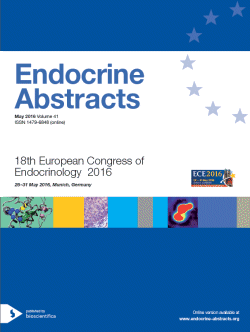Guided Posters
Receptors & Signalling
ea0041gp169 | Receptors & Signalling | ECE2016
Chemotherapy resistance and metastasis-promoting effects of thyroid hormone in hepatocarcinoma cells are mediated by suppression of FoxO1 and Bim pathway
Chi Hsiang-Cheng , Lin Kwang-Huei
ea0041gp170 | Receptors & Signalling | ECE2016
Altered exression of circadian clock genes in polyglandular autoimmune syndrome type III
Angelousi Anna , Nasiri-Ansari Narjes , Spilioti Eliana , Kalotychou Vasiliki , Chrousos George , Kaltsas Gregory , Kassi Eva
ea0041gp171 | Receptors & Signalling | ECE2016
Zebrafish as a new model to study in vivo the functional consequences of human THRA variants
Marelli Federica , Carra Silvia , Rurale Giuditta , Cotelli Franco , Persani Luca
ea0041gp172 | Receptors & Signalling | ECE2016
Increased 17beta-hydroxysteroid dehydrogenase type 1 mRNA level is correlated with poor prognosis in endometrial cancer
Cornel Karlijn , Krakstad Camilla , Jori Balazs , Bongers Marlies , Kruitwagen Roy , Salvesen Helga , Romano Andrea
ea0041gp173 | Receptors & Signalling | ECE2016
The changing ‘steroid metabolome’ across the spectrum of non-alcoholic fatty liver disease
Moolla Ahmad , Amin Amin , Hughes Bev , Arlt Wiebke , Hassan-Smith Zaki , Armstrong Matt , Newsome Philip , Shah Tahir , Van Gaal Luc , Verrijken An , Francque Sven , Biehl Michael , Tomlinson Jeremy
ea0041gp174 | Receptors & Signalling | ECE2016
5β-reductase (AKR1D1) is a regulator of glucose homeostasis in human hepatocytes and development of model systems to define its role in metabolic liver disease
Nikolaos Nikolaou , Dunford James , Green Charlotte , Lee Wenhwa , Lim Reina , Gathercole Laura , McKeating Jane , Oppermann Udo , Hodson Leanne , Tomlinson Jeremy
ea0041gp175 | Receptors & Signalling | ECE2016
Differential roles of estrogen receptors (ERα and ERβ) in seminiferous epithelium: in vivo agonist studies in adult rats
Dumasia Kushaan , Kumar Anita , Balasinor Nafisa
ea0041gp176 | Receptors & Signalling | ECE2016
Luteinizing hormone and human chorionic gonadotropin (hCG) action on the same receptor results in different in vitro intracellular signaling in mouse primary Leydig cells
De Pascali Francesco , Riccetti Laura , Poti Francesco , Tagliavini Simonetta , Trenti Tommaso , Simoni Manuela , Casarini Livio
ea0041gp177 | Receptors & Signalling | ECE2016
Characterization of the signaling and testicular functions of bone morphogenetic protein 8
ea0041gp178 | Receptors & Signalling | ECE2016
Salivary testosterone to androstenedione (T/A4) ratio is significantly higher in PCOS patients and accompanied with an adverse metabolic phenotype
Muenzker Julia , Lindheim Lisa , Adaway Jo , Lerchbaum Elisabeth , Pieber Thomas , Keevil Brian , Obermayer-Pietsch Barbara




